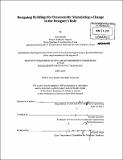Designing buildings for disassembly : stimulating a change in the designer's role
Author(s)
Gaïsset, Ines (Ines Sophie Maya)
DownloadFull printable version (10.54Mb)
Other Contributors
Massachusetts Institute of Technology. Dept. of Civil and Environmental Engineering.
Advisor
Jerome J.Connor.
Terms of use
Metadata
Show full item recordAbstract
Today's industrial infrastructure in the building field results in specific types of problems with current design strategies. Here, the potential of Design for Disassembly (DfD) is explored as a solution for a new type of architecture that allows for both recyclability of material and space. Particular attention is given to the benefits that result from this new way of designing while beginning the process of an industrial re-evolution. Indeed, if environmental and health impacts are the most obvious benefits, indirect effects such as questioning the boundary between the designer and the user should not be neglected. In addition, projects built with DfD methods are being analyzed. The studies range from houses that can expand in the longitudinal plan to houses that can be entirely customized. To further explore DfD methods, experiments based on digital fabrication technologies such as CNC, Water Jet Cutting and rapid prototyping are considered. Finally, conclusions as to how Design for Disassembly can stimulate a change in the designer's role in the building field, and recommendations on how to encourage the implementation of such an innovative and responsible design method are proposed.
Description
Thesis (M. Eng.)--Massachusetts Institute of Technology, Dept. of Civil and Environmental Engineering, 2011. Cataloged from PDF version of thesis. Includes bibliographical references (p. 61-63).
Date issued
2011Department
Massachusetts Institute of Technology. Department of Civil and Environmental EngineeringPublisher
Massachusetts Institute of Technology
Keywords
Civil and Environmental Engineering.